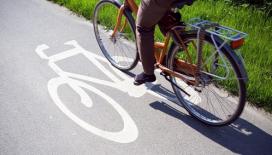Discoveries in D.C. and Delft: Reflections on the Future of Transportation Research
In the course of a year-long appointment to the Delft University of Technology in the Netherlands, Dr. Robert Bertini thinks he rode in an automobile a total of three times. “I took trams and trains, walked, rode a bike—I just had no need for a car,” said Bertini, a former Deputy Administrator of the U.S. Department of Transportation’s (DOT) Research and Innovative Technology Administration (RITA) and a professor of civil and environmental engineering at Portland State University.
Bertini shared his experiences and ideas from his time with the Dutch and his two years at the U.S. DOT during a recent speaker series event at Volpe, The National Transportation Systems Center.
“Let me tell you some things about the Dutch that indirectly bears on transportation,” he said, commenting on their good schools, children who swim safely in canals without adult supervision nearby, and multiple outdoor coffee shops. Nobody wears bike helmets, and children as young as eight go unsupervised on bicycles “because cyclists never interact with fast-moving vehicles. They’re always in their own tracks; they have priority…In the U.S., however, miscommunications can happen, cars cut off bikes, and people get hit.”
In Delft, the streets belong to the people, Bertini explained, sharing images of roads where cars are considered “guests” among the pedestrians and cyclists and must travel at very low speeds. Safety is created by engineering design: no signs are needed because paving colors, street size, and geometry make it obvious.
“It’s easy to understand where to go, what to do,” said Bertini, explaining that newly built cities are being designed to encourage non-automobile modes. Bertini acknowledged that the Dutch model is specific to the people, the flat landscape, and a culture that has developed in this small country with a history of tackling enormous engineering challenges. “Their culture does things that make sense and ultimately saves money, but it wouldn’t necessarily work everywhere.”
Bertini urged researchers to think creatively about what’s being measured, what’s being modeled, and how well it relates to "newer" transportation issues, such as sustainability. “We need to develop new performance measures and understand what our objectives are. Are we talking about transportation as a goal, or as something else?”
With a focus on performance measures in MAP-21, there is an opportunity to devise “clever ways to actually develop performance measures that can help states and regions and cities understand how the transportation system is operating,” said Bertini.
He would like to see transportation professionals reach beyond the “very simple fundamental measures, such as speed and flow,” and look more at the externalities of transportation.
Bertini advocated for a new focus on people and on how they use streets. As researchers, he said, we need to tell our stories in a way that policy people can grab onto, use, and implement. We need to explain things in “normal terms” so that people can understand visually what is possible, and to collaborate, joining forces to field test our theories and get the useful, relevant ideas out there. “We need your brains to help figure out how this is going to work in the future!”

